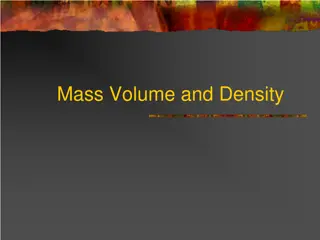Understanding Rock Mechanics and Strength Assessment in Tishk International University
Tishk International University delves into the challenges of assessing jointed rock masses and determining their strength. The Hoek-Brown failure criterion, developed through empirical data fitting, plays a crucial role. Back-analysis of failures offers insights, while predicting strength for large-scale rock masses remains a significant challenge in rock mechanics.
Download Presentation

Please find below an Image/Link to download the presentation.
The content on the website is provided AS IS for your information and personal use only. It may not be sold, licensed, or shared on other websites without obtaining consent from the author. Download presentation by click this link. If you encounter any issues during the download, it is possible that the publisher has removed the file from their server.
E N D
Presentation Transcript
TISHK INTERNATIONAL UNIVERSITY TISHK INTERNATIONAL UNIVERSITY Rock Mechanics TEC 18 Professor, Dr. Hamed M. Jassim
TISHK INTERNATIONAL UNIVERSITY TISHK INTERNATIONAL UNIVERSITY Week 4 Rock Mass Strength - 1
TISHK INTERNATIONAL UNIVERSITY TISHK INTERNATIONAL UNIVERSITY Rock Mass Strength The strength of jointed rock masses is notoriously difficult to assess. Laboratory tests on core samples are not representative of a rock mass of significantly larger volume. On the other hand, in situ strength testing of the rock mass is seldom practically or economically feasible.
TISHK INTERNATIONAL UNIVERSITY TISHK INTERNATIONAL UNIVERSITY Back-analysis of observed failures can provide representative values for large scale rock mass strength, but obviously, this is only possible for cases in which rock mass failure has occurred. The more general problem of forward strength prediction for large scale rock masses remains as one of the great challenges in rock mechanic.
TISHK INTERNATIONAL UNIVERSITY TISHK INTERNATIONAL UNIVERSITY The Hoek-Brown failure criterion is an empirical criterion developed through curve-fitting of triaxial test data. The conceptual starting point for the criterion was the Griffith theory for brittle fracture but the process of deriving the criterion was one of pure trial and error. The original Hoek-Brown criterion was proposed in 1980 (Hoek and Brown, 1980) and is defined as:
TISHK INTERNATIONAL UNIVERSITY TISHK INTERNATIONAL UNIVERSITY 1 = major principal stress at failure 3 = minor principal stress at failure c = uniaxial compressive strength of the intact rock material m = constant depending on the characteristics of the rock mass, s = constant depending on the characteristics of the rock mass,
TISHK INTERNATIONAL UNIVERSITY TISHK INTERNATIONAL UNIVERSITY The uniaxial compressive strength for the rock mass, c, rock mass , can be expressed by setting 3= 0 in Equation 1 thus obtaining of the rock mass, Equation 2.2: The uniaxial tensile strength of the rockmass, t rockmass , can be found by setting 1 = 0 in Equation 2.1, thus yielding: Equation 2.3:
TISHK INTERNATIONAL UNIVERSITY TISHK INTERNATIONAL UNIVERSITY For intact rock, s = 1 and m = mi. Values for mi can be calculated from laboratory triaxial testing of core samples at different confining stress, or extracted from reported test results. Hoek and Brown (1980) provided a relative thorough compilation of such data. In essence, they found trends suggesting that rock types could be grouped into five classes, with mi = 7, 10, 15, 17 and 25, respectively.
TISHK INTERNATIONAL UNIVERSITY TISHK INTERNATIONAL UNIVERSITY For jointed rock masses, 0 s < 1 and m < mi. The values for each of these parameters can be difficult to assess since this also requires triaxial testing. At that time there were very few such data sets available for rock masses (this is probably also true today).
TISHK INTERNATIONAL UNIVERSITY TISHK INTERNATIONAL UNIVERSITY PARAMETERS AFFECTING ROCK STRENGTH Rock strength depends on many parameters (Paterson, 1978) including: 1 - rock type and composition, 2 - rock grain size, 3 - rock weathering, 4 - rock density and porosity, 5 - rate of loading, 6 - confining stresses F2 and F3, 7 - geometry, size and shape of the test specimens, 8 - rock anisotropy, 9 - water pore pressure and saturation, 10 - testing apparatus (end effects, stiffness), 11 - temperature, and 12- time 12 - time.
TISHK INTERNATIONAL UNIVERSITY TISHK INTERNATIONAL UNIVERSITY Uniaxial Comp. Strength (MPa) (MPa) Specimen can only be chipped with a geological hammer Specimen requires many blows of a geological hammer to fracture it Grade* Term Point Load Index Field estimate of strength Examples Extremely strong Fresh basalt, chert, diabase, gneiss, granite, quartzite Amphibolite, sandstone, basalt, gabbro, gneiss, granodiorite, peridotite , rhyolite, tuff Limestone, marble, sandstone, schist 10 R 6 > 250 R 5 4 10 Very Strong 100 250 Strong 50 100 Specimen requires more than one blow of a geological hammer to fracture it Cannot be scraped or peeled with a pocket knife, specimen can be fractured with a single blow from a geological hammer Can be peeled with a pocket knife with difficulty, shallow indentation made by firm blow with point of a geological hammer R 4 2 4 Medium Strong Concrete, phyllite, schist, siltstone R 3 1 2 25 50 Weak 5 25 Chalk, claystone, potash, marl, siltstone, shale, rocksalt, R 2 ** Very Weak 1 5 Crumbles under firm blows with point of a geological hammer, can be peeled by a pocket knife Highly weathered or altered rock, shale R 1 ** Extremely Varoujan Sissakian Private Consultant Geologist 2018 2019 Weak R 0 ** 0.25 1 Indented by thumbnail Stiff fault gouge Rock Mechanics
TISHK INTERNATIONAL UNIVERSITY TISHK INTERNATIONAL UNIVERSITY
TISHK INTERNATIONAL UNIVERSITY TISHK INTERNATIONAL UNIVERSITY
TISHK INTERNATIONAL UNIVERSITY TISHK INTERNATIONAL UNIVERSITY
TISHK INTERNATIONAL UNIVERSITY TISHK INTERNATIONAL UNIVERSITY
TISHK INTERNATIONAL UNIVERSITY TISHK INTERNATIONAL UNIVERSITY Systems for tunneling: Quantitative 1) Rock Mass Rating (RMR) 2) Q-system 3) Mining Rock Mass Rating (MRMR)
TISHK INTERNATIONAL UNIVERSITY TISHK INTERNATIONAL UNIVERSITY 1) Rock Mass Rating (RMR) System is a geomechanical classification system for rocks, developed by Z. T. Bieniawski between 1972 and 1973. It combines the most significant geologic parameters of influence and represents them with one overall comprehensive index of rock mass quality, which is used for the design and construction of excavations in rock, such as tunnels, mines, slopes and foundations.
TISHK INTERNATIONAL UNIVERSITY TISHK INTERNATIONAL UNIVERSITY RMR 0 - 20 21 - 40 41 - 60 61 - 80 81 - 100 Rock quality Very Poor Poor Fair Good Very good
TISHK INTERNATIONAL UNIVERSITY TISHK INTERNATIONAL UNIVERSITY Rock Mass Rating RMR has found wide applications in various types of engineering projects such as tunnels, slopes, foundations, and mines. It is also adaptable for knowledge-based expert systems. Engineers informally classify rock structure into two general classifications: 1)continuous homogenous isotropic linear elastic (what most geotechnical engineers would like to see), and 2)discontinuous inhomogenous anisotropic non-elastic (what most in- situ rock masses actually are).
TISHK INTERNATIONAL UNIVERSITY TISHK INTERNATIONAL UNIVERSITY Recently, after over 40 years of use, renewed attention was paid to the RMR System because of its applications to the assessment of rock mass excavability (RME) and, especially, its direct correlation with the specific energy of excavation (SEE) for TBMs (Tunnel Boring Machine) used effectively to detect changes in tunneling conditions, in real time, thus serving as a warning of adverse conditions as construction proceeds.
TISHK INTERNATIONAL UNIVERSITY TISHK INTERNATIONAL UNIVERSITY Rock Mass Rating presents some difficulties when applied to rock slopes, since the parameter that take into account the influence of the discotinuities orientation is introduced in detail for dam foundations and tunnels but not for slopes. To address this issue, Romana defined Slope Mass Rating (SMR)scheme that is based on the original Bieniawski's parameters but including a rigorous definition of the parameters considering the effect of the orientation of discontinuities.























